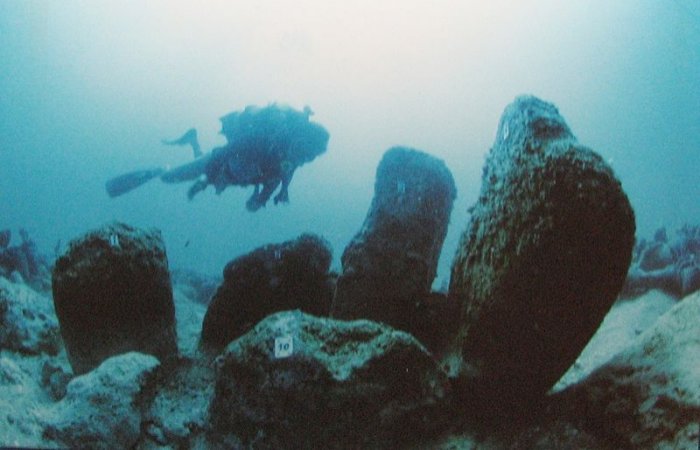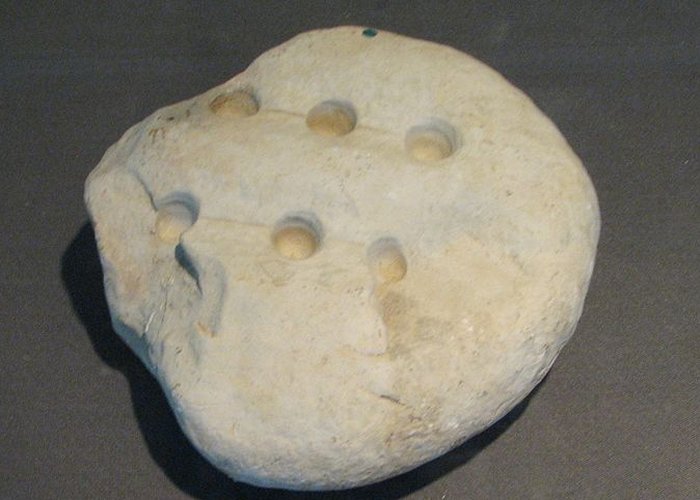Atlit Yam – Fate Of The 9,000-Year-Old Underwater Megalithic Site With A Huge Stone Circle
Jan Bartek - AncientPages.com - About 9,000 years ago, long before Stonehenge in the UK was constructed, a Neolithic society in Israel built a large stone circle using heavy megaliths. This ancient structure is now submerged, but what was its purpose?
Atlit Yam is an ancient submerged Neolithic village off the coast of Atlit, Israel. Credit: Hanay - CC BY-SA 3.0
Who were the inhabitants of the ancient underwater village, Atlit Yam? Why was their settlement flooded? What can we learn about these peoples' beliefs, traditions, and daily life from underwater surveys?
Who Were The People Living In Atlit Yam?
Atlit Yam is a Pre-Pottery Neolithic settlement submerged off the Carmel coast of Israel. Atlit Yam is an important archaeological place because the well-preserved finds at the site have provided scientists with helpful information about the burial practices of the Pre-Pottery Neolithic society. This is a subject researchers possessed little knowledge about before discovering Atlit Yam.
Many experts have examined the underwater remains of Atlit Yam, and the site has been carbon-dated to be between 9,000 and 8,300 years old.
Underwater archaeologists have discovered remains of rectangular houses, hearth-places, botanical remains, stone, and flint tools, as well as many well-preserved human remains resting beneath the water.
Based on the archaeological findings, scientists suggest Atlit Yam was a fishing village. The discovery of piles of fish ready for trade or storage indicates inhabitants of the Neolithic village suddenly abandoned their homes. Unfortunately, it seems not everyone managed to escape the natural disaster that destroyed Atlit Yam.
Game carved of limestone played by people living in Atlit Yam. Credit: Photography by Yosef Galili, Ehud Galili, Itamar Greenberg - CC BY-SA 3.0
Atlit Yam's "economy was based on integrated subsistence components, including terrestrial and marine resources – the so-called agro-pastoralmarine Mediterranean fishing village." 1
When examining the human skeleton belonging to both adults and children, scientists discovered 46 locations characterized as actual graves.
"Two burials contained three individuals each, 11 burials contained two individuals and 33 burials contained a single individual.
Most graves (71 percent) were shallow pits dug into the clay. None of these graves showed evidence of stone construction or surface marking." 1
Further examination of the underwater site revealed people living in the Atlit Yam village, sometimes referred to as the earliest-known agro-pastoral fishing community, often buried their dead in the vicinity of their house or even within the dwelling.
This "strongly suggests that even after death, an individual was still considered a member of the household." 2
Many people were buried in a flexed position on their sides or backs, which indicates the Atlit Yam people followed specific ritualistic burial customs unknown to scientists.
Scientists discovered "a number of skeletons exhibit signs of disease and health problems possibly caused by dietary or other environmental factors. For example, tuberculosis and arthritis were common, as are indications of infectious diseases, including those causing high fevers during childhood. Occasional bone breaks and cracks suggest traumatic injury as well." 2
Underwater archaeologists also discovered "stone foundations of several rectangular structures, paved floors, long straight walls, hearths, round megalithic structures, storage and production installation and water wells." All these submerged structures are embedded in dark clay.
Atlit Yam's Megaliths
Researchers examined Atlit Yam's megalithic installations and suggested these structures were used for certain rituals.
An artist's reconstruction of the Atlit Yam's large stone circle was looked like. Credit: Photography by Yosef Galili, Ehud Galili, Itamar Greenberg - CC BY-SA 3.0
The ritual installation of megaliths, "consists of seven stones (1-2.1 m long), six of which are still standing upright, forming a circle (diameter ca. 2.5 m) open to the northwest. The bases of the standing stones are covered with gray travertine attesting to the presence of fresh water in the past. Close to the standing stones to the west, a few flat stone slabs (0.7-1.2 m long) were found lying horizontally. On some of them were hewn shallow cup-marks.
It is suggested that these features formed part of a ritual structure, perhaps associated with a fresh-water spring that may have existed at the site. Another installation consists of three oval stones (1.6-1.8 m), two of which are circumscribed by grooves forming schematic anthropomorphic figures." 3
The End Of Atlit Yam
Sadly, the inhabitants of Atlit Yam, who relied on the sea in their daily life lived in a place that was not meant to survive. It is unknown how many people lived in the village at the time, but though it seems the village was abandoned before the natural catastrophe, some people may have still have perished when the waves covered the Neolithic settlement
"While the sea contributed to the prosperity and success of the community it may in the end, have been a major factor in the village's abandonment. At the time the village was lived in, the sea level was lower, and the coastline was about 1,000 feet to the west of the settlement. This lower sea level (about 45 feet below the present sea level) was the result of huge quantities of water being trapped in the glaciers much farther to the north.
Toward the end of the Pleistocene and beginning of the Holocene, as the glaciers began melting, sea levels began to rise slowly. At some point, with the encroachment of the sea, the shore was so close to the village that coastal dunes covered the area and continued habitation was no longer possible. Following abandonment, the village was submerged." 2
There are many interesting underwater archaeological sites along the Israeli coast, including Atlit Yam.
Updated on November 16, 2024
Written by Jan Bartek - AncientPages.com Staff Writer
Copyright © AncientPages.com All rights reserved. This material may not be published, broadcast, rewritten or redistributed in whole or part without the express written permission of AncientPages.com
Expand for references- Galili, E., Gopher, A., Eshed, V., & Hershkovitz, I. (2005). Burial Practices at the Submerged Pre-Pottery Neolithic C Site of Atlit-Yam, Northern Coast of Israel. Bulletin of the American Schools of Oriental Research,(339), 1-19.
- Galili, Ehud, Daniel Kaufman, and Mina Weinstein-Evron. "8,000 Years Under the Sea." Archaeology41, no. 1 (1988): 66-67.
- Israel Antiquities Authority - The Pre-Pottery Neolithic Site of Atlit-Yam
- Wikipedia - Atlit Yam
More From Ancient Pages
-
 Shangshan Culture Drank Ancient Rice Beer 10,000 Years Ago – Archaeological Evidence Found In China
Archaeology | Dec 13, 2024
Shangshan Culture Drank Ancient Rice Beer 10,000 Years Ago – Archaeological Evidence Found In China
Archaeology | Dec 13, 2024 -
 Ancient DNA Reconstructs Rise Of Largest Empires In History Of Inner Asia
Archaeology | Nov 6, 2020
Ancient DNA Reconstructs Rise Of Largest Empires In History Of Inner Asia
Archaeology | Nov 6, 2020 -
 Records Of Pompeii’s Survivors Have Been Found – Archaeologists Are Starting To Understand How They Rebuilt Their Lives
Featured Stories | Jun 13, 2024
Records Of Pompeii’s Survivors Have Been Found – Archaeologists Are Starting To Understand How They Rebuilt Their Lives
Featured Stories | Jun 13, 2024 -
 Has The Mystery Of The Secret Sarcophagus Found At Notre-Dame Cathedral Been Solved?
Archaeology | Sep 25, 2024
Has The Mystery Of The Secret Sarcophagus Found At Notre-Dame Cathedral Been Solved?
Archaeology | Sep 25, 2024 -
 Lost Laodicea Temple And Seleucid Relics – Archaeological Search Continues
Archaeology | Jun 29, 2020
Lost Laodicea Temple And Seleucid Relics – Archaeological Search Continues
Archaeology | Jun 29, 2020 -
 Secrets Of Legendary Viking Crystal Sunstones And The Mysterious Uunartoq Artifact Unraveled
Artifacts | Jun 3, 2015
Secrets Of Legendary Viking Crystal Sunstones And The Mysterious Uunartoq Artifact Unraveled
Artifacts | Jun 3, 2015 -
 Ancient Icelandic Drinking Horn Reveals An Interesting Story About Saint-King Olaf
Ancient Traditions And Customs | Mar 29, 2017
Ancient Icelandic Drinking Horn Reveals An Interesting Story About Saint-King Olaf
Ancient Traditions And Customs | Mar 29, 2017 -
 Why Was Pharaoh Hatshepsut’s Reign Virtually Erased From History?
Featured Stories | Nov 9, 2014
Why Was Pharaoh Hatshepsut’s Reign Virtually Erased From History?
Featured Stories | Nov 9, 2014 -
 Vikings May Have Made Imitation Gold Dinar Found In Morston, Norfolk – Expert Says
Archaeology | Apr 5, 2023
Vikings May Have Made Imitation Gold Dinar Found In Morston, Norfolk – Expert Says
Archaeology | Apr 5, 2023 -
 Rare Archaeological Discoveries In The Sacred Animal Necropolis In Saqqara
Archaeology | Apr 26, 2020
Rare Archaeological Discoveries In The Sacred Animal Necropolis In Saqqara
Archaeology | Apr 26, 2020 -
 Breakthrough – First Glimpse Into A 2,000-Year-Old Charred Herculaneum Scroll
Linguistic Discoveries | Feb 7, 2025
Breakthrough – First Glimpse Into A 2,000-Year-Old Charred Herculaneum Scroll
Linguistic Discoveries | Feb 7, 2025 -
 Was Mysterious Fontainebleau Forest Home To A Lost Civilization?
Ancient Mysteries | Aug 28, 2025
Was Mysterious Fontainebleau Forest Home To A Lost Civilization?
Ancient Mysteries | Aug 28, 2025 -
 Oseberg Ship: Amazingly Well-Preserved Viking Burial Ship
Featured Stories | Jun 15, 2016
Oseberg Ship: Amazingly Well-Preserved Viking Burial Ship
Featured Stories | Jun 15, 2016 -
 Extraordinary Viking Boat Burial Of Two People Unearthed In Central Norway
Archaeology | Nov 20, 2019
Extraordinary Viking Boat Burial Of Two People Unearthed In Central Norway
Archaeology | Nov 20, 2019 -
 First Genome-Wide Ancient Human DNA From Sudan Shines New Light On Nile Valley Past
Archaeology | Dec 20, 2021
First Genome-Wide Ancient Human DNA From Sudan Shines New Light On Nile Valley Past
Archaeology | Dec 20, 2021 -
 Puzzling Connection Between Native Americans And Lost Northern European Race Could Re-Write History
Ancient Mysteries | Apr 14, 2018
Puzzling Connection Between Native Americans And Lost Northern European Race Could Re-Write History
Ancient Mysteries | Apr 14, 2018 -
 Unexplained Mystery Of The Glowing Woman Who Baffled Scientists
Featured Stories | Jun 6, 2022
Unexplained Mystery Of The Glowing Woman Who Baffled Scientists
Featured Stories | Jun 6, 2022 -
 Denisovans In The Altai Mountains: A Hominin Group That Interbred With Modern Humans
Evolution | Nov 11, 2024
Denisovans In The Altai Mountains: A Hominin Group That Interbred With Modern Humans
Evolution | Nov 11, 2024 -
 Mysterious Ancient Tracks In Rock, Strange Legend And Hidden Treasure – A Puzzle From Arkansas
Featured Stories | Sep 3, 2024
Mysterious Ancient Tracks In Rock, Strange Legend And Hidden Treasure – A Puzzle From Arkansas
Featured Stories | Sep 3, 2024 -
 Neanderthals Invented Or Developed Birch Tar Making Technique Independently From Homo sapiens
Archaeology | May 30, 2023
Neanderthals Invented Or Developed Birch Tar Making Technique Independently From Homo sapiens
Archaeology | May 30, 2023



